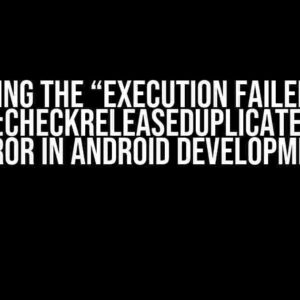Are you tired of relying on public Android images or emulators to test your apps? Do you want to have full control over the Android environment and create a customized host with a local Android image? Look no further! In this article, we’ll dive into the world of AOSP Cuttlefish orchestrator and explore how to create a host with a local Android image.
- What is AOSP Cuttlefish Orchestrator?
- Why Use AOSP Cuttlefish Orchestrator?
- Prerequisites
- Step 1: Clone the AOSP Repository
- Step 2: Build the Android Image
- Step 3: Create the Cuttlefish Instance
- Step 4: Start the Cuttlefish Instance
- Step 5: Interact with the Cuttlefish Instance
- Tips and Tricks
- Conclusion
What is AOSP Cuttlefish Orchestrator?
AOSP (Android Open Source Project) Cuttlefish is an open-source project that allows you to create a customized Android environment on your local machine. It’s an orchestrator that enables you to create, manage, and interact with Android instances, giving you full control over the Android environment. With Cuttlefish, you can create a local Android image, customize it to your needs, and use it to test your apps.
Why Use AOSP Cuttlefish Orchestrator?
There are several reasons why you should consider using AOSP Cuttlefish orchestrator:
- Customization: With Cuttlefish, you can create a customized Android environment that meets your specific needs. You can modify the Android image, add or remove packages, and configure the environment to your liking.
- Flexibility: Cuttlefish allows you to create multiple Android instances, each with its own customized environment. This gives you the flexibility to test your apps on different Android versions, screen sizes, and hardware configurations.
- Speed: Cuttlefish is faster than traditional Android emulators, making it ideal for continuous integration and continuous deployment (CI/CD) pipelines.
- Security: With Cuttlefish, you have complete control over the Android environment, which means you can implement advanced security measures to protect your apps and data.
Prerequisites
Before you start creating a host with a local Android image, make sure you have the following prerequisites:
- A 64-bit Linux machine (Ubuntu or Debian recommended)
- At least 4 GB of RAM (8 GB or more recommended)
- A compatible GPU (NVIDIA or AMD recommended)
- AOSP repository cloned locally (we’ll cover this in the next section)
Step 1: Clone the AOSP Repository
To get started with Cuttlefish, you need to clone the AOSP repository locally. You can do this by running the following command:
$: repo init -u https://android.googlesource.com/platform/manifest $: repo sync -j 8
This will download the entire AOSP repository to your local machine. Be patient, as this may take some time.
Step 2: Build the Android Image
Once you’ve cloned the AOSP repository, you need to build the Android image. This involves building the Android kernel, device tree, and system image. Here’s how to do it:
$: lunch aosp_cf_x86_64-userdebug $: make -j 8
This will build the Android image for the x86_64 architecture. You can modify the build configuration to suit your needs.
Step 3: Create the Cuttlefish Instance
Now that you have the Android image, it’s time to create a Cuttlefish instance. You can do this by running the following command:
$: cuttlefish create --image-path out/target/product/cf_x86_64/userdata.img
This will create a new Cuttlefish instance with the local Android image. You can customize the instance by specifying additional flags and options.
Step 4: Start the Cuttlefish Instance
Once the instance is created, you can start it by running the following command:
$: cuttlefish start
This will start the Cuttlefish instance, and you’ll see the Android boot animation on your screen.
Step 5: Interact with the Cuttlefish Instance
Now that the instance is running, you can interact with it using the `cuttlefish` command. Here are some examples:
$: cuttlefish shell $: cuttlefish adb $: cuttlefish screenshot
You can use these commands to interact with the Android environment, take screenshots, and debug your apps.
Tips and Tricks
Here are some tips and tricks to help you get the most out of your Cuttlefish instance:
- Use the `cuttlefish help` command to see a list of available options and flags.
- Customize the Android image by modifying the build configuration and adding or removing packages.
- Use the `cuttlefish snapshot` command to save the state of the instance and restore it later.
- Integrate Cuttlefish with your CI/CD pipeline to automate testing and deployment.
Conclusion
Creating a host with a local Android image using AOSP Cuttlefish orchestrator is a powerful way to customize and control the Android environment. With Cuttlefish, you can create multiple Android instances, each with its own customized environment, and interact with them using a variety of commands. By following the steps outlined in this article, you can create a Cuttlefish instance and start testing your apps in a customized Android environment.
| Command | Description |
|---|---|
cuttlefish create |
Creates a new Cuttlefish instance with the specified image. |
cuttlefish start |
Starts the Cuttlefish instance. |
cuttlefish shell |
Opens a shell session on the Cuttlefish instance. |
cuttlefish adb |
Opens an ADB session on the Cuttlefish instance. |
cuttlefish screenshot |
Takes a screenshot of the Cuttlefish instance. |
By mastering Cuttlefish, you can unlock the full potential of Android testing and development. Happy testing!
Frequently Asked Question
Get ready to dive into the world of AOSP Cuttlefish orchestrator and learn how to create a host with a local Android image!
What is AOSP Cuttlefish orchestrator, and how does it differ from traditional Android emulation?
AOSP Cuttlefish orchestrator is an open-source Android emulator that allows you to run Android on a Linux host. Unlike traditional Android emulation, Cuttlefish uses a unique approach that involves running the Android operating system on a virtualized environment, providing a more realistic and high-performance Android experience.
What are the benefits of using AOSP Cuttlefish orchestrator over traditional Android emulation?
The benefits of using AOSP Cuttlefish orchestrator include improved performance, better compatibility with Android apps, and a more realistic Android experience. Additionally, Cuttlefish allows for easier testing and debugging of Android apps, making it a popular choice among developers.
What are the system requirements for running AOSP Cuttlefish orchestrator?
To run AOSP Cuttlefish orchestrator, you’ll need a Linux host with a 64-bit architecture, at least 4GB of RAM, and a compatible graphics driver. You’ll also need to install the required dependencies, such as QEMU and virglrenderer.
How do I create a host with a local Android image using AOSP Cuttlefish orchestrator?
To create a host with a local Android image, you’ll need to download the AOSP Cuttlefish orchestrator source code, build the Cuttlefish components, and then create a new Android image using the `cuttlefish_ create_image` command. You can then start the Cuttlefish instance using the `cuttlefish_start` command.
Can I use AOSP Cuttlefish orchestrator for testing and debugging Android apps?
Yes, AOSP Cuttlefish orchestrator is an excellent choice for testing and debugging Android apps. It provides a realistic Android environment that allows you to test your apps in a variety of scenarios, including different screen sizes, languages, and hardware configurations.



